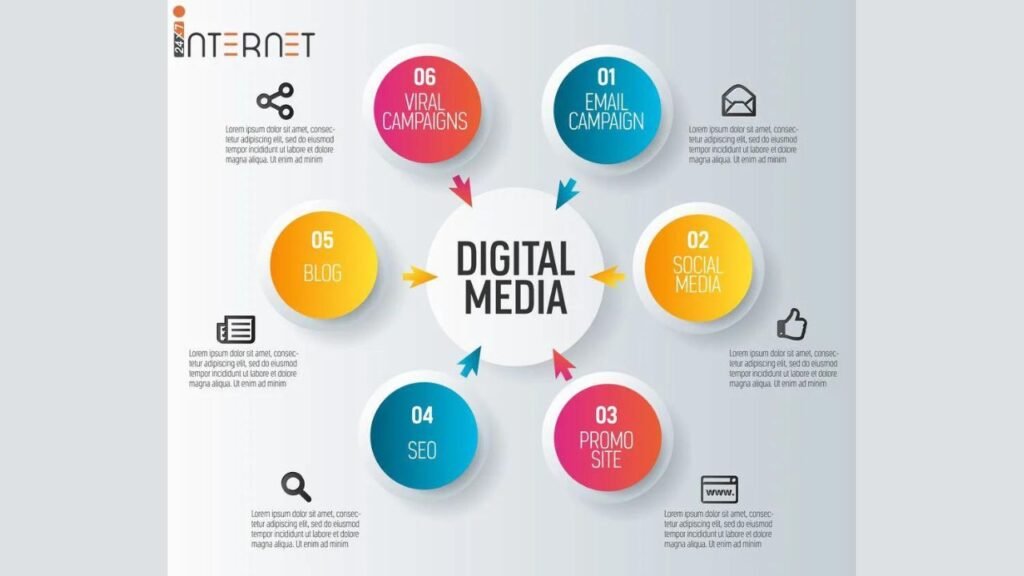The core concept of effective digital media engagement revolves around understanding and catering to the target audience, consistently creating relevant and high-quality content, leveraging analytics for informed decision-making, adapting strategies to various platforms, and fostering interactivity to build meaningful connections.
Finding Digital Media Engagement
Finding digital media engagement is crucial for businesses and individuals navigating the online landscape. It involves identifying target audiences, crafting compelling content, and utilizing analytics to refine strategies.
One can foster meaningful connections with audiences by understanding platform dynamics and embracing interactivity. From social media platforms to websites and email newsletters, the journey to effective engagement requires consistent effort and adaptability.
Whether it’s sparking conversations on Twitter, sharing visually appealing content on Instagram, or providing valuable insights on LinkedIn, each platform offers unique opportunities for engagement.
By staying informed about industry trends and leveraging innovative approaches, individuals and brands can successfully navigate the digital media landscape and cultivate loyal audiences.
Core Concepts of Effective Digital Media Engagement

Finding digital media engagement is crucial for businesses and individuals navigating the online landscape. It involves identifying target audiences, crafting compelling content, and utilizing analytics to refine strategies.
One can foster meaningful connections with audiences by understanding platform dynamics and embracing interactivity. From social media platforms to websites and email newsletters, the journey to effective engagement requires consistent effort and adaptability.
Whether it’s sparking conversations on Twitter, sharing visually appealing content on Instagram, or providing valuable insights on LinkedIn, each platform offers unique opportunities for engagement.
By staying informed about industry trends and leveraging innovative approaches, individuals and brands can successfully navigate the digital media landscape and cultivate loyal audiences.
Target Audience Identification
The foundation of effective engagement lies in knowing your audience inside out. This involves defining your target demographics, understanding their needs, preferences, and pain points, and tailoring your content accordingly.
Content Relevance and Quality
What is the Core Concept of Effective Digital Media Engagement? Creating relevant and high-quality content is paramount for maintaining audience interest and loyalty. Content should be informative, entertaining, and valuable to your audience, addressing their concerns and solving their problems.
Consistency in Communication
Consistency builds trust and credibility with your audience. Establishing a consistent brand voice, posting schedule, and messaging across all channels ensures your audience knows what to expect from you and when.
Utilization of Analytics
What is the Core Concept of Effective Digital Media Engagement? Data is a goldmine for understanding audience behavior and refining engagement strategies. Utilize analytics tools to track key metrics, such as engagement rates, click-through rates, conversion rates, and audience demographics, and adjust your approach accordingly.
Adaptability to Platforms
Different platforms have different audiences and dynamics. Tailor your content and engagement strategies to fit each platform’s unique characteristics, whether it’s the visual appeal of Instagram, the professional atmosphere of LinkedIn, or the conversational tone of Twitter.
Interactivity and Engagement Strategies
What is the Core Concept of Effective Digital Media Engagement? Encourage active participation from your audience by incorporating interactive elements into your content, such as polls, quizzes, contests, and live Q&A sessions. Engage with your audience directly by responding to comments, asking questions, and fostering meaningful conversations.
Measuring Success
Finding Digital Media Engagement is essential in today’s digital landscape. It involves understanding your audience, crafting compelling content, and leveraging various online platforms effectively. Identifying your target audience’s preferences and behavior is crucial for creating content that resonates with them.
Communication consistency and adaptability to different platforms are key factors in maintaining engagement levels. Utilizing analytics tools helps track performance metrics and make data-driven decisions.
Encouraging interactivity through polls, quizzes, and live sessions fosters active participation and strengthens connections with your audience. Ultimately, successful digital media engagement requires a strategic approach that prioritizes audience engagement and consistently delivers value.
By embracing these principles, businesses, and individuals can navigate the complexities of the digital world and forge meaningful relationships with their audience.
Regular and Solutions
Regular routines are essential for maintaining productivity and well-being, but they can also pose challenges when disruptions occur. However, implementing effective solutions can help mitigate these issues.
Individuals can navigate interruptions with resilience by establishing clear priorities, maintaining flexibility, and practicing self-care. Setting realistic expectations and embracing adaptability can alleviate stress and ensure continued progress toward goals.
Additionally, fostering open communication and seeking support from peers or mentors can provide valuable insights and assistance during periods of upheaval. Embracing a growth mindset and viewing disruptions as opportunities for learning and growth can further empower individuals to overcome obstacles and thrive in the face of change.
By embracing both the regularity of routines and the adaptability of solutions, individuals can maintain balance and resilience in their personal and professional lives.
Case Studies
Case studies serve as invaluable learning tools, offering insights into what works and what doesn’t in real-world scenarios. From viral social media campaigns to impactful influencer collaborations, these case studies provide concrete examples of effective strategies and tactics in action.
By analyzing the strategies, content, and audience responses of successful campaigns, marketers can glean valuable lessons and apply them to their initiatives.
Whether a small business seeks to increase brand awareness or a multinational corporation aims to drive conversions, studying case studies can illuminate best practices, creative approaches, and potential pitfalls to avoid.
Ultimately, case studies offer a roadmap to success in the ever-evolving landscape of digital media engagement, showcasing how strategic planning, creativity, and audience-centricity can yield impressive results.
Future Trends
The future of digital media engagement promises exciting developments as technology continues to evolve. Emerging trends include:
- The rise of augmented reality (AR) and virtual reality (VR) experiences.
- The increasing popularity of live streaming content.
- The personalization of user experiences.
- The growing influence of voice search.
These trends are reshaping how brands and individuals interact with their audiences, offering new opportunities for engagement and connection. As AR and VR technologies become more accessible, immersive storytelling experiences will become increasingly prevalent, providing users with unique and interactive content experiences.
On the other hand, live streaming allows for real-time interaction and engagement, fostering authentic connections between creators and their audiences. Personalized content tailored to individual preferences and behaviors will enhance engagement and drive deeper connections,
while voice search technology will revolutionize how users discover and consume content. By embracing these future trends, businesses and content creators can stay ahead of the curve and continue engaging their audiences innovatively.
How do you lay a Banner?
When laying out a banner, it’s crucial to consider design and messaging to capture attention effectively. Start by defining the banner’s purpose and target audience. Choose bold colors, eye-catching fonts, and high-quality images.
Keep the message clear and concise, focusing on a single call to action. Balance text and visuals for optimal impact, ensuring readability from a distance. Pay attention to dimensions and aspect ratios to fit various display spaces.
Consider the banner’s placement and surroundings to maximize visibility. Lastly, review the layout for coherence and consistency, eliminating clutter and unnecessary elements. Following these steps, you can create a compelling banner that grabs attention and effectively communicates your message.
What are two Important Characteristics of Digital Media?

Digital media encompasses a vast array of platforms and channels, each with its unique characteristics. Two crucial traits defining digital media are its interactivity and accessibility. Interactivity enables users to engage actively with content through likes, shares, comments, and interactive features, fostering deeper connections and participation.
Additionally, digital media’s accessibility allows for the widespread dissemination of information, reaching audiences globally in real time. These characteristics empower individuals and businesses to communicate, collaborate, and share ideas globally, democratizing access to information and enabling diverse voices to be heard.
Interactivity and accessibility are fundamental pillars of digital media, shaping how we consume, create, and interact with content online. Understanding and harnessing these traits are essential for effective digital media engagement and communication strategies.
How Does Digital Media Affect Society
What is the Core Concept of Effective Digital Media Engagement? Digital media has significantly impacted society, shaping how we communicate, consume information, and interact with the world. It has revolutionized communication by providing instant access to news, entertainment, and social connections.
However, it has also raised concerns about privacy, misinformation, and addiction. Social media platforms influence opinions, behaviors, and even political outcomes. The rise of online shopping has transformed commerce, while streaming services have changed how we access entertainment.
Digital media has bridged geographical divides, allowing for global connections and collaborations. Yet, it has also exacerbated issues like cyberbullying and online harassment. Overall, while digital media offers numerous benefits and opportunities, it also presents challenges that society must navigate as we continue to embrace and evolve with technology.
Conclusion
Effective digital media engagement is not a one-size-fits-all endeavor but a dynamic and ongoing process that requires continual adaptation, innovation, and audience-centricity. By mastering the core concepts outlined in this article and staying abreast of industry trends and best practices, you can create meaningful connections, foster brand loyalty, and drive tangible results in today’s digital landscape.
FAQ
What Important Facts About the Use of Digital Media Should the Designer Be Aware Of?
Final answer: The designer should be aware of the adaptability of digital media and the importance of creating a positive user experience (UX), and must be conversant with digital media laws and regulations
What is the Primary Purpose of a Banner Ad?
Banner ads utilize images instead of text and are a prevalent form of online advertising. Their primary aim is to boost brand visibility and attract visitors from the hosting website to the advertiser’s site.
What is most likely a Characteristic of an Effectively Designed Website?
So, it’s important to be visually appealing, polished, and professional. Allow white space and uncluttered layouts with quality photographs and graphics, and let your message shine through. (See examples.) Equally important, the site must work quickly, correctly, and as expected
What Principles Guide how Ads Should be Laid Out?
Key design principles for online advertising include clarity in messaging, attention-grabbing visuals, consistent branding, a compelling call-to-action, mobile responsiveness, simplicity in layout, contrasting colors, legible typography, fast loading times, and adherence to platform specifications.
What is the Concept of Digital Media?
Digital media involves the creation of audio, video, websites, social media, and applications using technology such as the Internet and electronics. Electronic devices can help design, update, and transmit digital media. Some examples of digital media include Social networking platforms.


